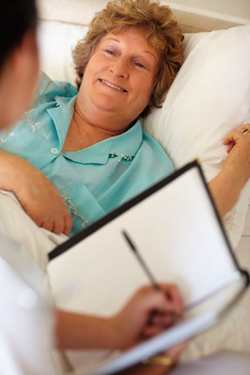- MENU
- HOME
- SEARCH
- WORLD
- MAIN
- AFRICA
- ASIA
- BALKANS
- EUROPE
- LATIN AMERICA
- MIDDLE EAST
- United Kingdom
- United States
- Argentina
- Australia
- Austria
- Benelux
- Brazil
- Canada
- China
- France
- Germany
- Greece
- Hungary
- India
- Indonesia
- Ireland
- Israel
- Italy
- Japan
- Korea
- Mexico
- New Zealand
- Pakistan
- Philippines
- Poland
- Russia
- South Africa
- Spain
- Taiwan
- Turkey
- USA
- BUSINESS
- WEALTH
- STOCKS
- TECH
- HEALTH
- LIFESTYLE
- ENTERTAINMENT
- SPORTS
- RSS
- iHaveNet.com: Health
Harvard Health

Once you're home, a doctor comes by at least once a day to check on you. A nurse comes two or three times a day for several hours until you re ready to be "discharged."
Hospitals are going out of their way these days to make patients feel like they're at home. Here's a logical extension of these efforts: offering hospital-level care at home. That's the premise behind a movement called Hospital at Home. It's already established in Italy, the Basque region in Spain, and other parts of Europe. Now, several groups are trying to give it a toehold in the United States.
The concept is simple. Instead of admitting patients to a hospital for relatively straightforward conditions like worsening heart failure, pneumonia, or an infection like cellulitis, doctors and nurses administer treatments in the patient's home. New communication technologies coupled with the miniaturization and portability of ultrasound and x-ray machines, devices for delivering intravenous (IV) medications, and other advances are making it easier and safer to do this.
Why bother? Because hospitals aren't the safest place to spend a few days. In its chilling report "To Err Is Human," the
"Hospital at Home can be a safe and effective option, and many people prefer to get care in the comfort of their homes," says Dr. Bruce Leff, associate professor of medicine at
Conditions that could be treated in a Hospital at Home setting include: atrial fibrillation, heart failure, pneumonia, urinary tract infection, exacerbation of Parkinson's or multiple sclerosis, deep-vein thrombosis, endocarditis, cellulitis, or other infections requiring intravenous antibiotics.
BUILDING A MODEL
The Hopkins model works like this: Say you go to a nearby emergency department because you're having trouble breathing. The doctors determine you have worsening heart failure and need to be hospitalized. If you aren't so sick that you need intensive care, you are given the choice to be admitted to the hospital or the Hospital at Home. Let's say you choose the home setting.
An ambulance takes you home, accompanied by a nurse and the equipment needed to monitor your condition and administer the IV diuretics and other medications that will remove excess fluid from your lungs and bloodstream and strengthen your heart. The nurse stays with you for an extended period of time to start your therapy. A doctor comes by at least once on the first day to check you out and see how things are going. After the first day, a nurse comes two or three times a day for several hours. A doctor visits at least once a day until you are ready to be "discharged."
DOES IT WORK?
In a 2005 study, the Hopkins team compared people treated in a standard hospital to those treated in a Hospital at Home. All patients were older, with an average age of 77, and needed hospital-level care for pneumonia, cellulitis, or worsening heart failure or chronic obstructive pulmonary disease.
Treatment was as successful in the Hospital at Home as it was in the hospital, with fewer incidents of delirium, fewer infections, and less use of sedation. Patients and family members generally said they were satisfied with the Hospital at Home experience. Other studies have shown lower rates of caregiver stress and better post-hospitalization function with Hospital at Home.
A report from
Interestingly, when the treatment was over, 16 percent of the hospitalized patients were transferred to a long-term care facility. In contrast, none of the Hospital at Home patients needed to be transferred elsewhere for long-term care; all remained at home. The downside was that caregivers of the Hospital at Home patients reported more stress than did those of hospitalized patients.
EXPANSION PLANS
So far, the only
Once you're home, a doctor comes by at least once a day to check on you. A nurse comes two or three times a day for several hours until you re ready to be "discharged."
© Harvard Health Watch
AGING | ALTERNATIVE | AILMENTS | DRUGS | FITNESS | GENETICS | CHILDREN'S | MEN'S | WOMEN'S
Bringing Hospital Care Home